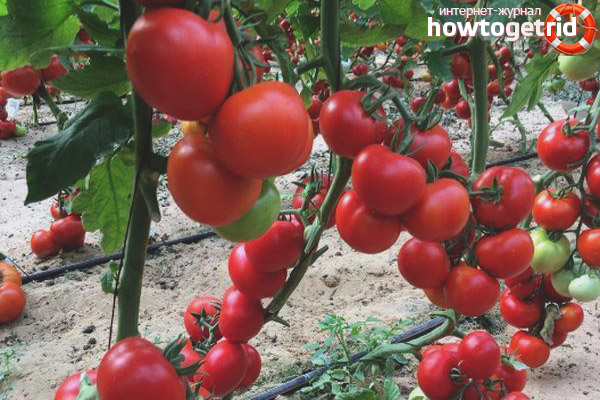The content of the article
The taste and benefits of tomato fruits constantly give breeders a reason to breed more and more productive and disease-resistant varieties and hybrids. This hybrid was bred by the breeders of the Russian company Semka.
Characteristic
Plants of this variety are primarily adapted for growing in greenhouses, but in the southern regions they can be grown in open ground. Fruit ripening begins less than 105 days after the full germination phase. According to the habit of the bush, the hybrid is indeterminate and compact. The pedicel, and then the peduncle is a brush, formed over the 9-11th sheet. Inflorescences are formed through 3 leaves. The number of leaves is average.
It is highly resistant to fusarium wilting, as well as to some viral diseases, in particular - tomato mosaic and yellow foliage twisting, as well as to such a pest as nematodes.
Fruits are recommended to be removed with whole brushes. Tomatoes have a rounded shape and intense red color. The surface is smooth, without green spots. The average density is typical for fruits. By weight, they grow to a maximum of 150 grams. They are considered juicy, but not watery.
By appointment, these are mainly salad vegetables, but can also be used for canning, in particular - the preparation of tomato paste.
Advantages of the hybrid:
- high productivity - up to 27 kg per 1 sq. km. m;
- resistance to certain diseases;
- high marketability and keeping quality of fruits.
Agricultural technology
The highest yield is usually achieved when growing in seedlings. Seeds are recommended to be sown in soil with a seeding to a depth of 1-2 cm. Seedlings should be tried to keep at a temperature of 21 degrees. After the appearance of two true leaves, seating in separate containers is recommended.
Vegetable growers usually recommend feeding on average 1 time in 10 days. As fertilizers, you can use both some mineral compounds, for example, Zdrazen, Fertika, as well as individual infusions from manure and extracts from biohumus, for example Gumistar, Gumidar. In any case, it is desirable that the phosphorus and potassium be a little more than nitrogen, so that the fruits are quite tasty. The manufacturer himself recommends avoiding mineral fertilizers, including complex ones with a relatively high nitrogen content, such as nitrophoska, azofoska, since the fruits are thus tasteless. Therefore, it makes sense to add ash or potassium monophosphate to the organic matter.
As for the formation, as the bush grows, stepsons should be removed, as well as leaves below the first flower brush. In addition, the main stem and brushes with fruits should be tied to the trellis, if grown in a greenhouse or to stakes, since it is planned to grow in open ground.
Pest and disease protection
The tops of this hybrid can be affected by several fungal diseases, including late blight, cladosporiosis, macrosporiosis. Therefore, both prophylactic and therapeutic treatments are appropriate.
For prophylaxis, it is useful to spray with a biofungicide, for example, Alirin-B or Bactofit in a prophylactic concentration (for Alirin: 1 tablet / 1 liter of water) in combination with an immunity inducer, for example, Immunocytophyte or Bak-Ecogel and microfertilizer, such as Uniflor-micro,Tsitovit, Aquadon-micro. For the maximum effect, biofungicides should be used three times with an interval of 5-7 days. At the initial stage of the disease, you can do with the use of fungicides, including chemical ones, such as Ordan, Profit, 1% Bordeaux mixture. In addition, you can control the spread of infections with the help of the drug Farmayod. Macrosporiosis sometimes manages to cure bushes with Alirin-B. In any case, when choosing a drug, one must take into account the waiting period of a particular product and the availability of fruits. That is, if less than 20 days remain before they mature, then ordinary chemical fungicides cannot be used.
Now for the pests. One of the first pests that start to eat tomatoes are wireworms - the larvae of the beetles. To protect against them, there are both chemical and biological preparations. Provotox can be attributed to the first, and Nemabakt and Anthem-F to the second. Of ground pests, whiteflies and scoops can be harmful to tomatoes. Against whiteflies, one can recommend Iskra, Intavir, and against caterpillars a scoop gnawing fruit is better to use one of such biological products as Fitoverm and Lepidotsid.
Video: 10 mistakes when growing tomatoes










Submit